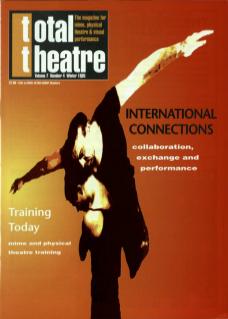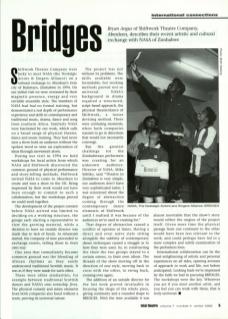Shiftwork Theatre Company were lucky to meet NASA (the Nostalgic Actors & Singers Alliance) on a cultural exchange to Aberdeen's twin city of Bulawayo, Zimbabwe in 1994. On our initial visit we were overawed by their magnetic presence, energy and very enviable ensemble style. The members of NASA had had no formal training, but demonstrated a real depth of performance experience and skills in contemporary and traditional music, drama, dance and song from southern Africa. Similarly NASA were fascinated by our work, which calls on a broad range of physical theatre, dance and music training. They had never seen a show hold an audience without the spoken word, or seen an exploration of ideas through movement alone.
During our visit in 1994 we held workshops for local artists from which NASA and Shiftwork discovered the common ground of physical performance and story-telling methods. Shiftwork invited NASA to come to Aberdeen to create and tour a show in the UK. Being impressed by their work would not have been enough to commit to such a collaboration, but the workshops proved we could work together.
The development of the project content before NASA arrived was limited to deciding on a working structure, the groups each electing a representative to view the growing material, while a decision to have no outside director was made due to lack of funds. As rehearsals started, the company of nine proceeded to exchange stories, telling them in their own way.
One area that immediately became common ground was the blending of African rhythms as they easily underscored traditional Scottish music. It was as if they were made for each other.
There were other similarities, for example between traditional Scottish dances and NASA's own township Jives. The physical comedy and mime elements from both companies also fused without a seam, proving its universal nature.
The project was not without its problems. The skills available were formidable, but working methods proved not so universal. NASA's background in drama required a structured, script-based approach; the physical theatre/dance of Shiftwork, a looser devising method. There were confusing moments, when both companies wanted to go in directions that would not necessarily converge.
But the greatest challenge for the Zimbabwean performers was creating for an unknown audience. Director of NASA, Mike Sobiko, said: ‘Theatre in Zimbabwe is very simple, our audiences don't have very sophisticated tastes. I was concerned about the degree of abstraction coming through the contemporary dance elements of Shiftwork until I realised it was because of the audiences we're used to creating for.’
That degree of abstraction caused a conflict of opinion at times. Having a direct and even naive style sitting alongside the subtlety of contemporary dance techniques caused a struggle as to how they were used. So, in constructing the show the two groups stayed, to a certain extent, in their own idiom, the threads of the show moving off in the direction of one style, moving back to cross with the other, to swing back, crossing over again.
The addition of an outside director for the last week proved invaluable in focusing the shape of the whole piece, giving continuity and a rounded shape to Bridges. With the time available it was almost inevitable that the show's story would reflect the origins of the project itself. Given more time the physical passage from one continent to the other would have been less relevant to the work, and could perhaps have led to a more complex and subtle examination of the performers’ lives.
International collaboration can be the most enlightening of artistic and personal experiences on all sides, opening avenues of approach to work and life not before anticipated. Looking back we're impressed by the faith we had in pursuing Bridges. The workshops were the key. Wherever you are if you meet another artist, and you feel you can work with them, that is truly universal.

